Maximizing Indoor Herb Growth with Proper Lighting
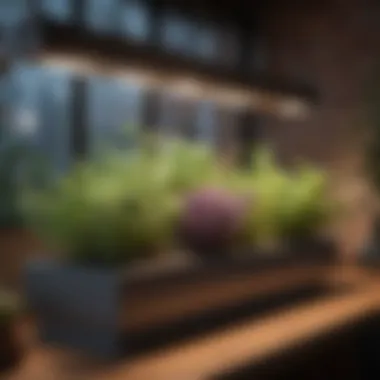
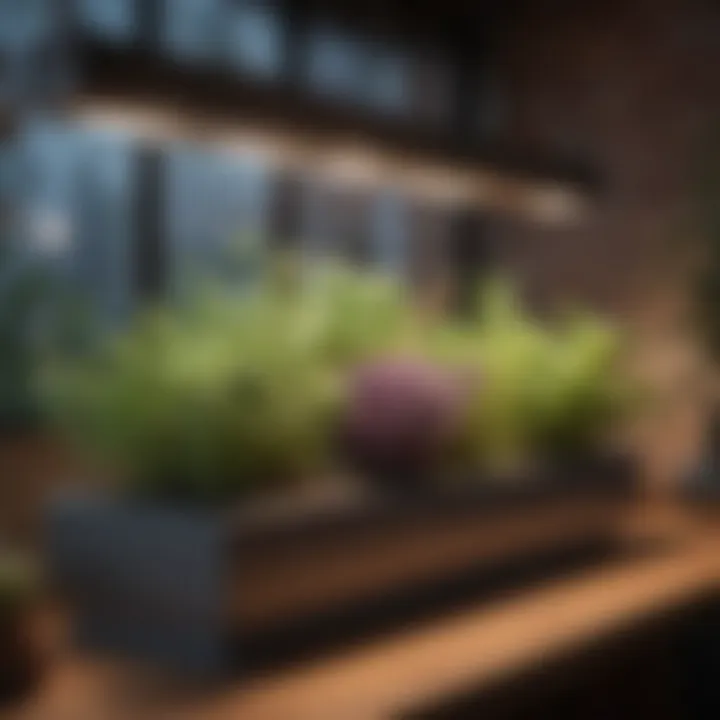
Intro
Indoor gardening has gained traction among enthusiasts and everyday folks alike, and for good reason. There’s something profoundly satisfying about cultivating your own fresh herbs right in your kitchen or living space. But let’s face it—growing herbs indoors isn’t quite as simple as tossing a few seeds in a pot. A key player in the success of your indoor herb garden is light. Sufficient light is crucial to not just germinate seedlings but to sustain robust growth, enhancing flavor and health.
By understanding the specifics of plant light, from intensity to duration, you empower yourself to create an environment that mirrors natural conditions as closely as possible. The purpose here is simple yet profound. From common herbs like basil and parsley to the more exotic varieties, each has its own tailored light needs that can influence growth and yield significantly.
Light requirements can vary wildly not just between different types of herbs but also across stages of their life cycle. Proper light not only helps in photosynthesis but also prevents diseases that thrive in poorly lit environments. Hence, this guide aims to provide a clear roadmap for indoor gardeners, equipping you with the knowledge to optimize your lighting strategy for culinary herbs.
Featured Homes
Though indoor gardening brings a personal touch, the right kind of atmosphere can enhance the experience. Every unique home offers a backdrop rich with potential for herb cultivation. Let’s explore how the right light presence can align with interior design, resonating well within featured homes.
Architectural Highlights
From minimalist apartments to quaint cottages, the design of a home can significantly influence how light enters and interacts with space. Picture a sun-drenched kitchen with expansive windows, where sunlight pours in during the golden hours of the morning and late afternoon—this setup is ideal for placing pots with herbs like rosemary and thyme. Alternatively, if you reside in an area where natural light is scarce, integration of artificial lights like LED grow lights become an architectural necessity. Think of how a vertical garden on a sleek wall display could utilize both natural and artificial light to enforce structure while making a bold statement.
Interior Design Themes
Bringing plants into your interior design is not only beneficial for aesthetics but also for air quality and mood. However, it requires careful consideration of light placement. Whether your theme leans towards bohemian with eclectic plant pairings or a more contemporary vibe with clean lines, having the right lighting setup can help these plants flourish. For instance, using pendant lights above a herb station or strategically placed track lighting can create a focal point while supporting plant growth.
"Light is an essential ingredient in the recipe for a successful indoor herb garden—a stitch in the fabric of your home’s ambiance."
Choosing the right light for your herbs might seem trifling compared to color schemes or furniture arrangements, but without that soft, life-giving illumination, your efforts could fall flat. Knowing how to position each light source can carve out distinct zones within your living space, ideally suited for your indoor garden pursuits.
Finale
By exploring how plant light intertwines with the aesthetics and practicality of interior spaces, we can see its importance as more than a mere afterthought. It’s an essential factor in indoor gardening that enhances both the growth of herbs and the beauty of the home, offering a harmonious blend of nature and design.
Understanding the Importance of Light in Herb Growth
When it comes to cultivating herbs indoors, light plays a pivotal role in ensuring that those little green gems thrive. In the world of indoor gardening, understanding the nuances of light is akin to decoding a recipe. Each herb has its unique requirements, and knowing how to cater to these can mean the difference between a lush harvest and a sad pot of wilting leaves.
The importance of light transcends mere growth; it affects everything from the plant's flavor profile to its overall health. Without adequate light, herbs may grow leggy, exhibit poor color, and lack the aromatic compounds that make them so desirable in culinary applications. Thus, optimizing light conditions is not only beneficial but necessary for achieving robust plants.
It's critical to recognize that plants rely on light for the process of photosynthesis, where they convert light energy into chemical energy. This process fundamentally underpins plant health and growth, making a comprehensive understanding of light requirements essential for every indoor gardener.
Key Benefits of Proper Lighting:
- Enhanced Growth: Sufficient light boosts photosynthesis, promoting healthier and faster growth.
- Better Flavor: Certain herbs develop their unique taste profiles only under the right light conditions.
- Increased Yield: Well-lit herbs will produce higher yields, making your effort worthwhile.
Considerations in Light Management:
- Quality vs. Quantity: Not all light is created equal – the quality and spectrum of the light are just as important as the duration.
- Adjustable Settings: Many modern lighting systems allow for adjustments in intensity and duration, accommodating the needs of different herbs throughout their growth phases.
- Natural Light vs Artificial: While some may rely heavily on natural sunlight, it’s crucial to consider how artificial lighting can enhance indoor conditions, especially in less-than-ideal locations.
In summary, grasping the importance of light sets the foundation for any successful indoor herbal garden. As we move forward in this article, we will explore photosynthesis fundamentals and the specific light spectrum requirements for optimum plant health.
Types of Light for Indoor Herbs
Lighting is a cornerstone in the complexion of indoor herb gardening. The types of light available furnish an array of options for growing conditions, and knowing which is best can make or break your herb garden's success. Each light type brings its own unique benefits and considerations for temperature, efficiency, and growth potential. Understanding these nuances empowers gardeners to choose wisely, fostering thriving plants that can impart flavor and fragrance to culinary dishes.
Natural Sunlight
Natural sunlight remains the gold standard for growing herbs, revered for its full-spectrum advantages. When this light shines in through a window, it nurtures plants with a symphony of wavelengths, enhancing the process of photosynthesis. The sun's rays also carry beneficial UV radiation, a component that is often missed in artificial light sources. In a home setting, a south-facing window generally gives the best chances for sun-loving herbs like basil and thyme.
Yet, sunlight isn't a one-size-fits-all solution. The angle of light shifts with the seasons, sometimes leaving your herbs peering anxiously at their sunless abode during winter months. Simultaneously, some places may get too much glare, scorching sensitive greens. Hence, if you go the natural route, having a reliable way to manage direct exposure is key.
LED Grow Lights
LED grow lights are emerging as a favorite in the indoor gardening space due to their versatility and energy efficiency. With a lifespan that often stretches to tens of thousands of hours, these lights use substantially less power compared to traditional incandescent or fluorescent options. By emitting specific wavelengths, LED lights can be tuned for maximum effectiveness, making them suitable for various plant types from seedlings to mature herbs.
One of their standout features is the minimal heat production. Unlike incandescent options which can crank the thermostat, LEDs remain cool to the touch, allowing plants to sit comfortably close without the risk of heat stress. As a bonus, they don’t contribute to the unsightly electric bill that often makes homeowners shudder.
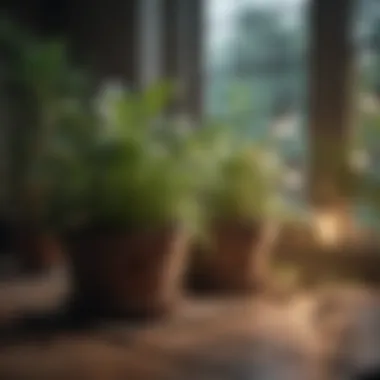
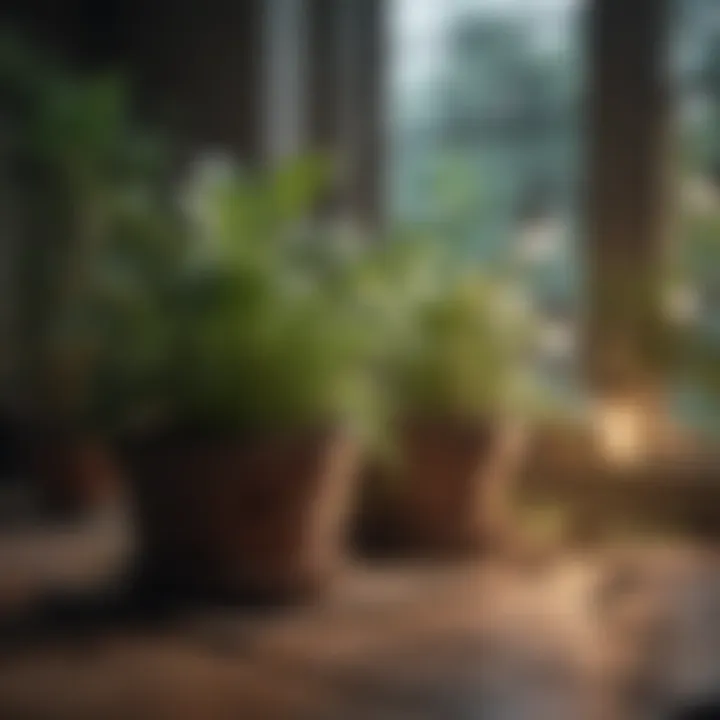
"Investing in quality LED grow lights can be a game changer, offering adjustable spectrum options that maximize growth potential for diverse herb varieties."
Fluorescent Lights
Fluorescent lights, particularly the T5 variety, have been a long-standing choice for indoor gardeners. These provide a cool light that’s gentle on the herbs and can fit snugly into any setup. The low heat output makes it easy to hang them just a few inches above herbs without causing any damage. In addition, these lights tend to give off a balanced spectrum that promotes growth across many kinds of culinary herbs.
Yet, be mindful of placement. While they do well for plants that enjoy plenty of light, herbs in low-light situations might struggle under fluorescent bulbs unless you keep those lights running for longer periods. The energy efficiency is commendable, but not all fluorescent lights pack the same punch, so looking for full-spectrum options can help cultivate stronger plants.
Incandescent Light Considerations
Incandescent lights have largely fallen out of favor among serious indoor gardeners due to their high-energy consumption and low efficiency in the realm of plant growth. They emit a spectrum with a heavy red bias, which can promote flowering but ill-serving to herbs that require balanced light for overall health. If you do use incandescent bulbs, it’s best to pair them with other types of lighting to create a full and even spectrum of light.
A notable disadvantage is also the excess heat they generate, which can create a warm environment that might stress your herbs, particularly those that thrive in cooler settings. If you lean toward this kind of lighting for aesthetic or accent purposes, be ready to swap it out for something more plant-friendly when it comes to serious growth.
As you consider your indoor herb garden, weighing the merits of each lighting type can guide you toward cultivating a lush and productive space brimming with flavor. The right choice depends on multiple factors—from your specific herb selections to the energy costs involved. Getting it right helps make the journey rewarding for both the gardener and the table.
Determining Light Requirements for Specific Herbs
Knowing the specific light needs of your herbs is key for successful indoor gardening. Different herbs thrive under various light conditions. Understanding these requirements means better growth, healthier plants, and, ultimately, a more bountiful harvest. Each herb has its own nuances, and recognizing these could be the difference between a flourishing pot of greens and a sad collection of wilted leaves.
Basil: A Sun-Loving Herb
Basil is often regarded as the star player among culinary herbs, and not just because of its flavor. It craves sunlight like a kid craves candy. Ideally, basil thrives with 6 to 8 hours of light each day. Grow it close to a south-facing window or under a strong grow light. It’s like a sunflower, turning its leaves toward the light, so ample exposure can yield larger, lusher plants.
When basil doesn’t get enough light, it can turn tall and leggy, searching for sunlight. Alternatively, overexposure might scorch its tender leaves. So, finding that sweet spot is vital. Remember, healthy basil looks vibrant and robust, not stretched thin.
Mint: Tolerant of Varied Conditions
Mint is the easy-going friend of the herb world. It adapts well to a range of light conditions, from full sun to partial shade. Just a few hours of bright light each day will suffice. This flexibility is a boon for beginners or those who can’t always optimize light conditions.
That said, too little light can impede its growth while excessive heat can aid pests. Therefore, keeping an eye on moisture and temperature is essential. When mint's leaves are dark, lush, and fragrant, you know it’s a happy camper.
Cilantro: Thriving in Partial Shade
Cilantro is a bit of a conundrum. In hotter climates, it prefers some shade to prevent bolting — when it flowers and stops producing the juicy leaves we love. Aim for around 4 to 6 hours of light, especially induring the warmer months. A bright window will suit cilantro just fine.
The challenge is managing water; it's easy to overwater when growing cilantro indoors. Keep an eye out for wilting, as it doesn’t like soggy roots. Healthy cilantro should be bushy and fragrant, signalling it’s happy with its light arrangement.
Parsley: Balancing Light and Quality
Parsley walks a fine line between adequate light and overall quality. This herb enjoys moderate light, preferably about 4 to 6 hours per day. Too much direct sunlight can lead to faded leaves and diminished flavor, while too little light will yield sparse growth. It’s about quality over quantity with parsley.
Moreover, parsley can be tricky regarding its water requirements. It prefers to be consistently moist but not drenched. Ideally, you’ll want to give it a good drink if the top inch of the soil feels dry. Lush green leaves and a robust scent are signs that parsley is growing well.
Ensuring the right light conditions for each herb not only promotes healthier plants but also enhances their flavors.
Understanding the light requirements for specific herbs will empower you in your indoor gardening journey. This knowledge is vital for creating flourishing and robust plants. After all, a well-lit herb garden can be a delight, and providing proper conditions leads to harmonious growth.
Plant Light Positioning and Maintenance
Plant light positioning and proper maintenance are crucial aspects for anyone attempting to nurture herbs indoors. Many times, people overlook this area, thinking that merely having any light source will do the trick. However, where you place that light source - and how you look after it - can significantly influence the health and vitality of your indoor garden. This section sheds light on vital factors to consider, ensuring your herb plants receive maximum benefits from their lighting setups.
Optimal Distance from Plants
Figuring out the right distance between the light source and your herb plants can be like walking a tightrope. Too close, and you risk scorching the delicate leaves; too far away, and the plants might stretch towards the light, causing leggy growth that's more appearance than vigor. For most LED grow lights, a general rule of thumb is to start at least 12 to 24 inches away. Keep an eye on your plants. You might need to adjust based on how they respond.
A closer look at light intensity can help.
- Low-light herbs like basil can manage fairly well with a height adjustment of about 12 inches.
- High light seekers like rosemary might thrive best with a bit more height, emphasizing their need for intensity.
"Understanding the distance of your lights isn’t just about comfort; it’s about creating an environment where your herbs can flourish."
Rotating Your Herbs for Even Growth
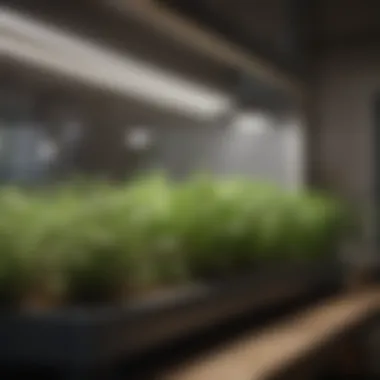
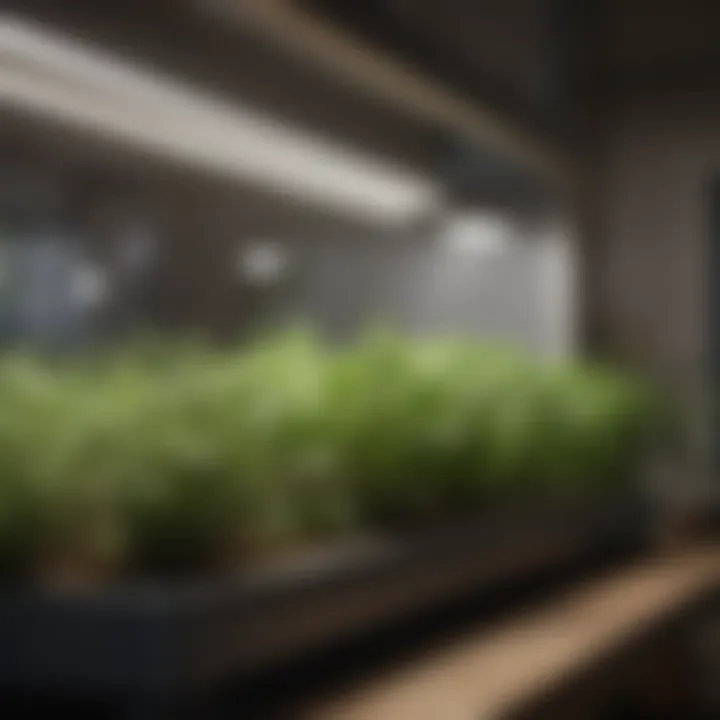
Rotating pots is an form of simple maintenance that packs a powerful punch. When growing herbs indoors, some parts of the plant may receive more light than others, leading to uneven growth. By turning pots every week or so, you can help all sides of the plant get their fair share of light. Depending on how much light your herb setup gets daily, this practice can be a game-changer.
Moreover, turning plants allows for:
- Improved airflow around each plant, reducing risks of mold and mildew.
- Lessons on light adaptation—over time, your vegetations can adapt better as they learn to reach for light sources directly.
Cleaning Light Fixtures
It might surprise you, but dusty light fixtures can hamstring your herbs even before they’ve had a chance to grow. Accumulated dirt and grime can drastically reduce light output, rendering all your careful positioning worthless.
Cleaning your fixtures is easy. You just need
- A soft cloth or microfiber—perfect for avoiding scratching.
- Gentle soap mixed with water—always use minimal moisture; nobody wants water droplets getting into wiring.
Make cleaning part of your routine, ideally once a month. Clear fixtures can mean better light absorption, leading to happier plants.
Thus, integrating these practices can greatly improve your indoor herb gardening. With careful positioning, regular rotation, and diligent cleaning, your herb plants can receive the utmost nourishment from their light sources, leading to lush and healthy growth.
Light Duration: Timing for Growth
Understanding the right duration of light exposure is crucial when it comes to nurturing herbs in an indoor garden. Plants are not just passive recipients of light; they are intricate organisms that respond to the quantity and quality of light they receive. This section will delve into how light duration impacts plant growth and what specific needs various herbs possess.
Recommended Light Hours for Herbs
Different herbs have distinct light requirements, often dictated by their natural habitats. On average, most herbs thrive with about 12 to 16 hours of light per day. Consider this as a guiding principle:
- Basil typically shines best with around 14-16 hours of light daily. Its growth is stunted or leggy under low light, signaling a need for more exposure.
- Mint, being quite adaptable, requires about 12-14 hours, making it easier to grow even in slightly less ideal conditions.
- Cilantro prefers a slightly shorter light duration, 10-12 hours, as it can bolt quickly in too much light.
- Parsley does well with around 12 hours daily, and this can help maintain its flavor profile.
These hours are not one-size-fits-all. Climate variations, seasons, and indoor conditions can influence the number of light hours needed. It is wise to use a timer to maintain consistency, making sure your herbs are getting their fill without you having to keep track of it all.
"Light duration plays a pivotal role in the metabolic processes of plants. Too little or too much can tilt the balance in ways that might halt growth altogether."
Role of Darkness in Plant Life
Often overshadowed by the spotlight on light, darkness is equally important for plant health. All plants, including herbs, undergo essential biochemical processes during the dark hours, such as respiration and nutrient absorption. Let’s explore how darkness aids in their development:
- Nighttime Respiration: When the sun sets, plants switch gears from photosynthesis to respiration, a process where they absorb oxygen and break down sugars for energy. This is when the plant recuperates from the day’s photosynthetic activities.
- Rest Period: Just like humans need to sleep, plants need their downtime. This rest period is vital for growth and recovery. The duration of darkness should mirror the light exposure to maintain a healthy rhythm.
- Growth Regulation: Darkness triggers hormonal changes that govern growth. For instance, in some herbs, longer nights may induce flowering or encourage bushier growth.
Thus, when setting up your indoor garden, getting the light-dark balance right is fundamental. Streamlining this cycle will lead to healthier and more vigorous herbs, ensuring your little indoor garden thrives throughout the seasons.
Understanding Light Intensity
Light intensity is a fundamental concept in indoor gardening, particularly when it comes to growing herbs. It describes how much light a plant receives, and this factor is crucial for photosynthesis, the process through which plants harness light energy to produce food. Just like a chef carefully measures spices, a gardener must pay attention to light intensity to ensure that herbs thrive rather than just survive.
Indoor herbs, which are often grown with limited natural light, require specific light intensities to flourish. The distance from the light source, type of light used, and duration of exposure all play significant roles in determining how much light intensity the herbs actually receive. Understanding these dynamics can prevent common problems, such as stretched-out plants or burnt leaf edges, leading to a robust herb garden.
Measuring Light Intensity: Tools and Techniques
To effectively measure light intensity, you can utilize a light meter, specifically designed for horticultural purposes. These devices provide readings in foot-candles or lux, offering a clear understanding of illumination levels. For those on a budget, smartphone apps can also give decent estimations of light levels based on camera functionality.
Some simple techniques to assess if your herbs are getting enough light include:
- Shadow Test: Observe the shadows cast by plants. Well-lit areas will have crisp, well-defined shadows.
- Plant Behavior: Look for signs of 'stretching,' where plants grow taller and lean toward the light source. This might indicate insufficient intensity.
Signs of Insufficient Light
When herbs do not get ample light, they show clear symptoms. Recognizing these early signs can save your plants from extended poor health. Common indicators of insufficient light include:
- Yellowing leaves, usually starting from the bottom.
- Short, leggy stems that indicate stretching toward the light.
- Slow growth or stunted development overall.
If your plant starts dropping its leaves like they’re going out of style, it might be waving a red flag that it needs brighter light.
Recognizing Light Burn Problems
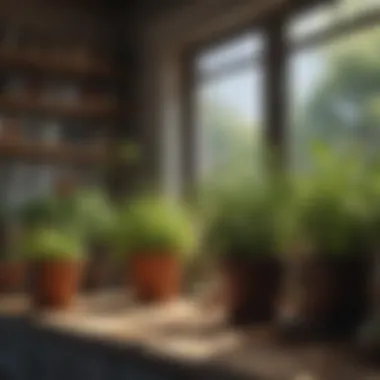
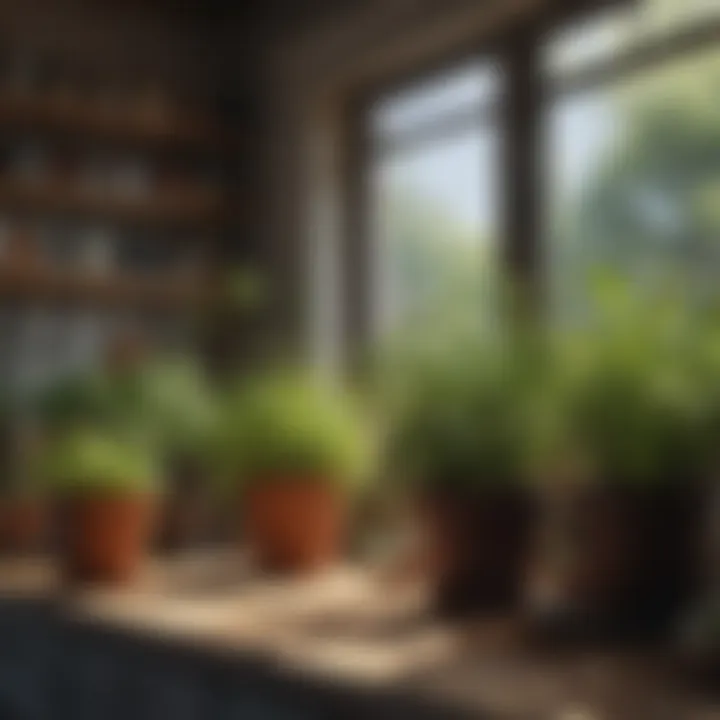
Conversely, while too little light can be detrimental, too much can be just as harmful. Light burn occurs when plants receive excessive light intensity, often resulting in scorched leaves. This usually manifests as:
- Brown or crispy leaf edges.
- Pale, bleached-looking patches that ruin the vibrant green forehead.
- Wilting leaves even when water is abundant.
To manage light burn, consider adjusting the distance between the light source and the plants or increasing the duration of darkness. Keeping an eye on your herb's response makes you a better steward of their growth.
"Just as plants have their preferred light, every gardener must learn the dance of balance in rising to meet their needs."
Knowledge of light intensity paves the way for successful herb gardening. Balancing the inputs ensures flourishing plants that stand their ground, all while bringing color and flavor to the kitchen.
Common Issues in Indoor Herb Gardening
Growing herbs indoors can be a rewarding endeavor, but it doesn’t come without its fair share of challenges. Understanding the common issues related to indoor herb gardening is crucial for both novice and experienced gardeners. Addressing these issues not only optimizes growth but also enhances the overall health and flavor of the herbs you cultivate. Here, we’ll delve into the primary concerns that indoor gardeners face, focusing on light-related problems, pest management, and environmental factors that can wreak havoc on an otherwise flourishing herb garden.
Diagnosing Light-Related Problems
One of the most common issues for indoor gardeners is the improper lighting of their herbs. Plants, especially herbs, have specific light requirements that, if unmet, lead to stunted growth or other health issues. Signs of inadequate light can include leggy growth, pale leaves, and a noticeable lack of new shoots.
To diagnose light issues, first check the placement of your herbs in relation to the light source. If they’re too far away, the plants will stretch toward the light, which is a tell-tale sign they're looking for more.
- Symptoms of insufficient light:
- Stretched or leggy stems
- Yellowing leaves
- Slow or stunted growth
On the flip side, too much light can also cause problems. Intense light, especially direct sunlight through glass, can lead to light burn—characterized by scorched leaf edges or browning. Therefore, observing your plants regularly is key. Adjust the distance from the light source and experiment with different lighting setups if needed.
Pests and Disease Management
Indoor herb gardens can often fall prey to pests and diseases that can dramatically affect growth. Aphids, spider mites, and whiteflies are common culprits that might find their way to your leafy greens. While indoor gardening minimizes some risks, these pests can still thrive in the right conditions.
Preventative strategies include:
- Regular inspection: Check your plants weekly for any signs of pests—small webs, discolored leaves, and visible insects.
- Healthy plants: Stressed plants attract pests, so ensure they receive adequate light and moisture.
- Natural predators: Consider introducing beneficial insects like ladybugs that prey on aphids.
It’s also essential to treat any outbreaks promptly using methods such as neem oil or insecticidal soap that target pests without compromising the plant’s health.
Environmental Factors to Monitor
Lastly, overlooking environmental factors can lead to issues that hinder growth. Humidity, temperature, and air circulation all play a vital role in the thriving of your indoor herb garden.
- Humidity: Herbs like basil and cilantro thrive in humid environments. A drop in humidity could lead to dry, brittle leaves. Using a small humidifier might help, especially in colder months.
- Temperature: Most herbs grow best in temperatures between 65°F and 75°F. Sudden temperature changes can stress your plants, impacting their growth negatively.
- Air circulation: Stagnant air can foster a breeding ground for mold and mildew. Ensure that there’s adequate airflow around your plants to prevent these issues.
Maintaining a balanced environment is essential; this helps in fostering robust herb growth and minimizes the risks from pests and diseases.
In summary, facing these common issues requires constant attention and a willingness to adapt. By monitoring light conditions, managing pest populations, and keeping an eye on environmental factors, you’ll significantly improve your chances for a successful indoor herb garden.
The Future of Indoor Plant Lighting
As we stride deeper into the 21st century, the way we approach indoor gardening is undergoing a transformative shift. The future of indoor plant lighting sits at the intersection of cutting-edge technology and sustainable practices. This section of the article addresses not only the innovations shaping the lighting landscape but also the broader implications for herb cultivation and home gardening enthusiasts. Implementing advanced plant light systems can significantly elevate the growth potential of herbs, which is invaluable for those looking to enhance their culinary experiences through home gardening.
Innovations in Light Technology
In recent years, the advancements in light technology for indoor gardening have been nothing short of remarkable. One noteworthy innovation is the development of smart grow lights, which can be controlled remotely through smartphone apps. These lights allow gardeners to monitor and adjust their light schedules based on real-time data, making it possible to create an optimal growing environment tailored to specific herbs. Also, these advancements offer users the ability to set timers, adjust light intensity, and even switch between different light spectrums, allowing for greater flexibility.
Another exciting shift is the emergence of full-spectrum LED lights. Unlike traditional options, these lights mimic natural sunlight much more faithfully, affecting not only growth but also the flavor profiles of the herbs being cultivated. Consider basil, for instance; research has shown that using full-spectrum light can enhance its essential oil content, leading to a more intense flavor. By integrating these advanced systems into indoor gardening practices, herb enthusiasts can create more robust and flavorful plants.
"With new technology, the possibilities are endless. Growers can tailor environments for their plants in ways that were once unimaginable."
Moreover, the ongoing research into adaptive lighting systems promises to revolutionize how we approach indoor gardening. These systems adjust light conditions dynamically based on the plant's growth stage and external environmental factors. Such precision can help prevent issues like light burn while ensuring that every herb gets the right amount of light for healthy growth.
Sustainability Considerations
As we embark on the journey toward enhanced indoor gardening practices, sustainability plays a crucial role. The future of plant lighting is not just about harnessing advanced technologies; it’s equally about doing so responsibly.
One important consideration is the energy efficiency of new lighting systems. Modern LED technology consumes significantly less power than traditional lighting options, making them a more sustainable choice. As enthusiasts switch to energy-efficient solutions, they not only help to reduce their carbon footprint but also cut down utility costs—an attractive perk for anyone tending to indoor gardens.
Additionally, focusing on sustainable materials for light construction, such as recyclable components, is vital. As consumers become more environmentally conscious, the market for sustainable gardening solutions is likely to grow. This shift opens up possibilities for entrepreneurs and manufacturers willing to merge innovation with ethical practices.
Moreover, the role of plant lighting in addressing urban food deserts cannot be overlooked. By utilizing efficient, sustainable lighting options, individuals can produce fresh herbs and vegetables right in their homes, regardless of their geographical location. This capability highlights the potential for indoor garden setups to contribute to community sustainability efforts.







